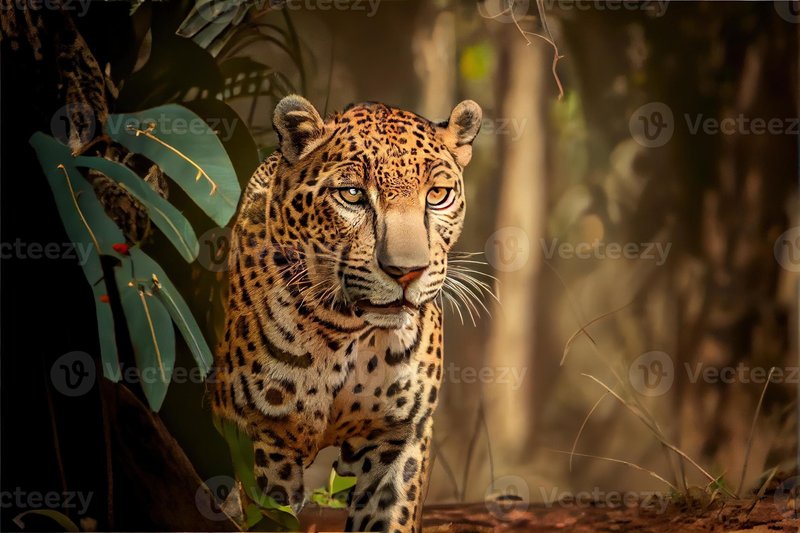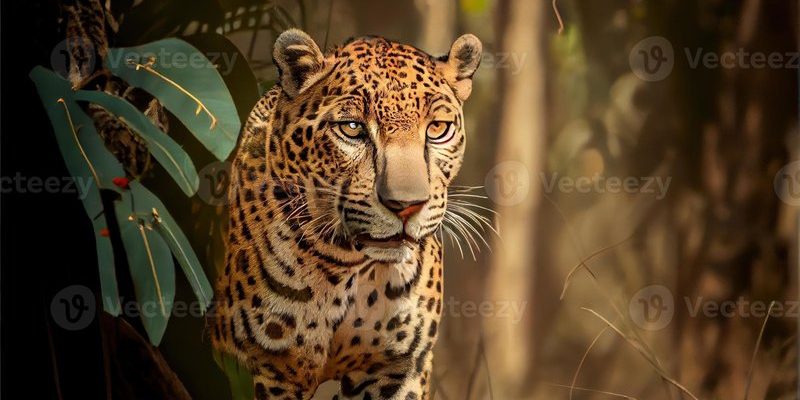
Imagine walking through a dense jungle, the air thick with humidity. Suddenly, you hear a rustle in the bushes. It’s not just any animal; it’s a jaguar, the largest cat in the Americas. With its striking coat patterned in rosettes and its powerful build, the jaguar isn’t just beautiful—it’s a formidable predator. These big cats are often seen as symbols of strength and agility, and for good reason.
The jaguar is distinctive not only in appearance but also in behavior. They are solitary hunters, known for their incredible ability to adapt to various environments, from swamps to rainforests. In this article, we’ll delve into the fascinating world of the jaguar, exploring its habits, habitats, diet, and conservation status. You’ll find that understanding these magnificent creatures can deepen our appreciation for the natural world.
Physical Characteristics of Jaguars
The jaguar is a striking animal, easily recognizable by its coat. Their fur is typically a golden yellow with black rosettes, but they can also be seen in a rare black form due to a genetic trait called melanism. Jaguars can weigh between 100 to 250 pounds, with males being significantly larger than females. On average, a jaguar measures about 5 to 6 feet long, with tails adding another 2 to 3 feet to their impressive stature.
One of the most remarkable features of the jaguar is its powerful jaw. Their bite is one of the strongest of all felines, capable of crushing the shells of turtles and the skulls of capybaras. This unique adaptation allows them to eat a wide variety of prey, making them opportunistic hunters. Their sharp claws are retractable, helping them climb trees stealthily and pursue prey.
| Characteristic | Description |
| Size | 5 to 6 feet long, excluding tail |
| Weight | 100 to 250 pounds |
| Habitat | Tropical rainforests, wetlands, and savannas |
| Diet | Carnivorous – focuses on large mammals, fish, and reptiles |
| Average Lifespan | 12 to 15 years in the wild |
Habitats and Range
Jaguars are primarily found in Central and South America, inhabiting a variety of ecosystems. They thrive in tropical rainforests, where their spotted coat provides excellent camouflage among the dappled sunlight. However, they can also be found in savannas, scrublands, and wetlands. Their adaptability is one of the reasons they have survived for thousands of years.
Historically, jaguars roamed as far north as the southwestern United States. However, due to habitat loss and human encroachment, their range has significantly diminished. Today, they are primarily located in areas like the Amazon Basin, the Pantanal, and parts of Mexico. Conservation efforts are underway in many of these regions to protect their habitats and ensure a sustainable environment for future generations.
The jaguar’s habitat is crucial not just for their survival but also for the ecosystem. As apex predators, they help maintain the balance of their environment by controlling prey populations and facilitating healthy biodiversity. Every time a jaguar stalks its territory, it plays an essential role in keeping the ecosystem vibrant.
Diet and Hunting Techniques
Jaguars are classified as carnivores, meaning their diet consists primarily of meat. They are known for their diverse diet, which can include deer, peccaries, capybaras, and even caimans. Interestingly, they are also one of the few big cats that enjoy swimming, often hunting for fish in rivers and lakes.
What sets jaguars apart from other big cats is their unique hunting technique. Instead of stalking and chasing their prey like lions or tigers, jaguars tend to ambush. They can move silently through the underbrush, relying on their keen eyesight and hearing. Once they’ve spotted their target, they pounce with impressive speed and power.
A defining characteristic of jaguar hunting is their method of killing. Rather than simply biting the neck, they often deliver a powerful bite to the skull or shell of their prey, using their strength to break through bone. This ability allows them to take down larger animals, securing a meal that can last for days. Their meal strategy showcases their adaptability and hunting prowess, which are critical for their survival in the wild.
Behavior and Social Structure
Jaguars are solitary animals, preferring to live alone except during mating season or when a mother is raising her cubs. Their territorial nature means they typically establish home ranges that can vary greatly in size depending on the availability of prey. Male jaguars have larger territories than females, often overlapping with the ranges of several females.
Communication among jaguars happens primarily through vocalizations, scent marking, and visual cues. They are known for their deep, throaty roars that can carry a long distance, which serves to warn other jaguars of their presence. When it comes to mating, males will compete for females, showcasing their strength and fitness through displays of aggression and prowess.
Mother jaguars are fiercely protective of their cubs. After a gestation period of around 93 to 105 days, a mother will give birth to a litter of 1 to 4 cubs, usually in a secluded den. The cubs are born blind and rely entirely on their mother for food and protection. They will stay with her for about two years before becoming independent, learning essential survival skills from her along the way.
Conservation Status and Threats
Today, the jaguar faces numerous threats that have led to its classification as near threatened by the International Union for Conservation of Nature (IUCN). Habitat destruction is the most significant factor affecting their populations, primarily due to deforestation for agriculture, logging, and urban development. As their natural habitats shrink, jaguars are forced into smaller territories, leading to conflicts with humans.
Illegal hunting poses another serious threat. Although jaguars are not typically hunted for sport, they are often killed to protect livestock or due to fear. Trade in jaguar parts, such as their pelts, also contributes to the decline of their numbers. Conservation efforts are vital now more than ever to protect these magnificent creatures.
Several organizations are actively working to protect jaguars and their habitats. Establishing protected areas, promoting sustainable land use, and educating local communities about the importance of jaguars in the ecosystem are essential steps. As we continue these efforts, we must remember that preserving the jaguar means safeguarding the rich biodiversity of the rainforests and wetlands they inhabit.
FAQ
What do jaguars eat in the wild?
Jaguars are opportunistic carnivores, meaning they eat a wide variety of animals. Their diet can include deer, capybaras, peccaries, and smaller mammals. They are also known for their unique hunting technique of eating fish and reptiles when available, showcasing their adaptability. This varied diet helps them thrive in different environments.
Are jaguars dangerous to humans?
Jaguars are generally not a threat to humans. They are shy and prefer to avoid human contact. Most conflicts arise when they are protecting their territory or if they feel threatened. Jaguars may attack livestock, which can lead to negative interactions with farmers. However, attacks on humans are extremely rare.
How fast can a jaguar run?
Jaguars are not the fastest cats; they can run up to 50 miles per hour in short bursts. Their hunting strategy relies more on stealth and power than speed. They often use cover to stalk their prey, allowing them to ambush rather than chase.
What is the lifespan of a jaguar in the wild?
In the wild, a jaguar typically lives around 12 to 15 years. Factors such as habitat loss, poaching, and competition for food can affect their lifespan. In captivity, with proper care, they can live longer, sometimes exceeding 20 years.
How do jaguars communicate?
Jaguars communicate through various methods, including vocalizations such as growls, roars, and mews. Scent marking is also an essential form of communication, allowing them to establish territory and signal reproductive status. Visual cues, such as body language and the physical displays during mating, are also used to communicate with other jaguars.
Are jaguars social animals?
Jaguars are primarily solitary creatures. They establish and defend their territories, with males typically having larger ranges than females. They do come together during the mating season, and mothers stay with their cubs until they are old enough to fend for themselves, usually around two years of age.
What efforts are being made to protect jaguars?
Conservation efforts for jaguars include establishing protected areas, promoting sustainable land use, and educating local communities about their role in the ecosystem. Organizations work to mitigate human-jaguar conflicts, such as providing compensation for livestock losses. International cooperation is also vital, as jaguars span multiple countries.
Can jaguars swim?
Yes, jaguars are excellent swimmers! They often enjoy swimming in rivers and lakes, catching fish and other aquatic creatures. Their strong bodies are well-adapted for swimming, and they are one of the few big cats that actively seek out water in their habitat.
How can I help jaguars?
You can help jaguars by supporting conservation efforts in their native habitats and spreading awareness about their plight. Donations to wildlife organizations, participating in eco-friendly tourism, and minimizing your environmental footprint can all contribute positively. Every small action can make a significant difference in the fight to protect these magnificent big cats.
What is the current population status of jaguars?
Estimating the exact population of jaguars can be challenging due to their elusive nature and the vast areas they inhabit. However, it is estimated that there are between 15,000 to 250,000 jaguars left in the wild. Their populations are declining in many areas due to habitat loss and hunting, which is why conservation efforts are crucial.
Do jaguars have any natural predators?
Adult jaguars typically have no natural predators due to their size and strength. However, cubs can fall victim to larger animals, including other predators like crocodiles or even larger felines. The biggest threats to jaguars come from humans through habitat destruction and poaching, rather than other animals.

